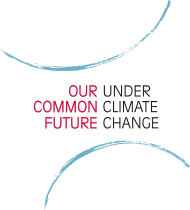�
Our Common Future Under Climate Change
International Scientific Conference 7-10 JULY 2015 Paris, France
One day's carbon dioxide emissions. Carbon visuals
Could bioenergy and carbon capture help reverse our emissions?
201507-06
By Our Common Future
In the wide, open plains of Illinois, whispering fields of corn stretch away as far as the eye can see. When harvest time comes, the ears are picked by giant machines and packaged up for animal feed and, increasingly, for conversion to biofuel.
So far, the world is tracking along the highest carbon dioxide emissions scenarios envisaged by the IPCC. Energy efficiency, renewable energy technologies and nuclear need to be rapidly deployed in order to prevent us from us from levels of warming which may be in excess of 4�C by 2100.�
But there may come a time when we need to look at ways of actively hoovering up greenhouse gas emissions from the atmosphere in order to prevent the worst of climate change.�
That�s where the cornfields of Illinois and other crops around the world come in.�
Dr Sabine Fuss leads the working group Sustainable Resource Management & Global Change for the Mercator Research Institute on Global Commons and Climate Change (MCC). She is speaking at the Our Common Future under Climate Change conference in Paris on Thursday 09 July at 17:30 in a session entitled 3307: Negative emissions for climate change stabilization & the role of CO2 geological storage.�
She will be discussing the concept of �negative emissions.�
�One strategy that is currently widely discussed is the deliberate removal of CO2 from the atmosphere by human intervention; that is, not merely going carbon-neutral, but even carbon-negative,� she says.�
She says the production of sustainable bioenergy with carbon capture and storage (BECCS) is one of the ideas gaining currency at the moment.�
�If growing biomass for feedstock sequesters about as much CO2 as is released during its combustion to generate energy, then capturing and storing the CO2 emissions from the combustion in addition will actually lead to an extraction of carbon dioxide from the atmosphere,� she says.�
She says many 2�C scenarios envisaged by the IPCC use BECCS, while a few rely on large-scale afforestation, to remove about 10 Gt CO2 per year from the atmosphere by 2100.�
However BECCS is not without its limits. At the same conference, Andy Wiltshire from the UK Met Office will discuss the climate effects of large-scale deployment of BECCS.�
Wiltshire points out that �limits on BECCS means that deep and rapid cuts to CO2 emissions are still required if the 2�C target is to be met.�
There�s also the problem of land use. Cultivating large amounts of biomass as feedstock for carbon-neutral bioenergy demands space, as does feeding a growing and hungry population.�
�For BECCS, large amounts of biomass would be needed as feedstock and also large-scale afforestation would need more land. It is thus important to understand where and to which extent this can happen without compromising other policy goals demanding land such as ensuring food security or conserving biodiversity or other ecosystems services. Clearly, intensification will have implications for needs of water and fertilizer, which also need to be taken into account,� says Dr Fuss. �
However if the world is to explore all possible options in the fight against climate change, BECCS will be a strategy that increases in interest as time goes on �BECCS is also a technology still in development, more research into the technology and trials are required to prove its viability at the large scales required to offset fossil fuel emissions,� said Dr Wiltshire�
As Dr Fuss puts it, �It is not only important to understand when negative emissions will be needed and in which form they can be sustainably and cost-effectively achieved in theory, but it also needs to be put into the context of where such options would be deployed.�
This is part of a blog series profiling climate scientists, economists, social scientists and civil society members who are presenting and discussing innovative climate science at Our Common Future. For more follow and #CFCC15 on Twitter.



